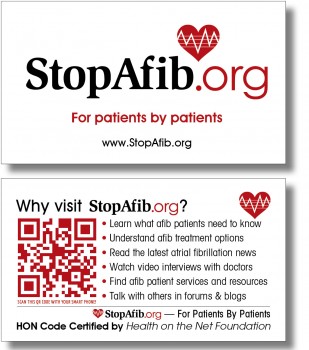
StopAfib Mobile Site
There are many who are quick to dismiss what they do not understand well, and this certainly applies to the QR code.
QR codes are much more than a means for connecting the virtual and physical worlds. They are mobile triggers that are portable, and therefore shareable.
Consider what would happen if you could unify multiple communities that share a common challenge, some as users and others as influencers. What would happen if you could bring them all together to share their experiences and expertise?
Read further for a practical example of how QR codes successfully created awareness of a life-threatening condition whose origins are uncertain, while also bringing to bear resources to help those affected by it.
Non-Promotional QR Codes
I met Mellanie True Hills last year while researching uses of QR codes for a chapter I was writing for the book Speak More: Marketing Strategies to Get More Speaking Business.
Mellanie and I are both members of the National Speakers Association, which published Speak More. After submitting my chapter, the editors decided it would be better if I had an example of another speaker using QR codes. So, I reached out to the NSA community via our Facebook Group.
What attracted me to Mellanie’s story was how she used QR codes in a non-promotional way to solve a problem – with the result changing her life and business for the better.
Here it is.
The Story of Stop Afib
Atrial fibrillation (afib for short) is the most common irregular heartbeat condition, and a major cause of deadly and debilitating strokes. Mellanie is an atrial fibrillation survivor, having had surgery to stop this condition.
Once she was afib-free, she couldn’t sit on the sidelines and watch others suffer, so she started StopAfib.org, a non-profit patient advocacy organization for those living with this condition. StopAfib.org provides a wealth of resources for those dealing with this condition, including video interviews with the world’s top afib doctors.
To help doctors help their patients, Mellanie created a non-promotional patient card with a QR code that links to important atrial fibrillation resources. The StobAfib site is purely educational, and the mobile version readily serves up videos and other valuable content via the QR code.

What has resulted from these efforts has been nothing short of amazing as StopAfib.org has become the go-to source for atrial fibrillation information. And Mellanie has become the go-to speaker for medical conferences and hospital events about the patient perspective on atrial fibrillation.
Using QR codes to Share Practical Resources
One of the more common inquiries I receive is how to make a video go viral. In fact, I even wrote an article to answer that question and it gets abundant clicks every day.
Going viral occurs when people encounter something so interesting, entertaining, or useful that they are compelled to share it. That’s the secret behind the success of Stop Afib.
It’s a QR code success story like no other.
If you’d like more, here’s a recent video about how Mellanie came to create Afib Awareness Month.
Is it possible that QR codes should be used more for sharing than marketing?
Are you rethinking how you can use QR codes more effectively?
Leave a comment below and share your thoughts below.
Until next time, Jeff




Facebook Page Comments Go Public
Today Facebook announced new changes at their f8 conference. There is always a lot of hoopla and excitement associated with this annual event, though I’ll reserve my comments for later. My ongoing promise to you is to not just report the news – but to give you a thoughtful perspective on what it means for […]
Read the full article